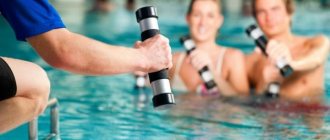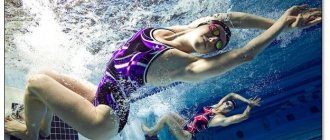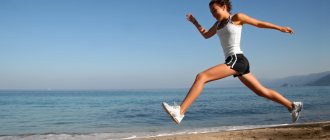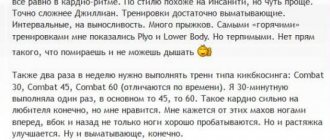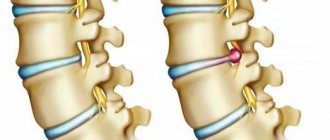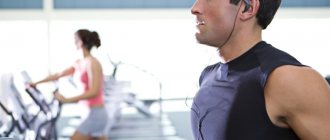Swimming is rightfully considered a unique sport. This type of physical activity helps strengthen the immune system, improve the activity of the heart muscle, increase lung capacity and, of course, lose weight. On average, one hour-long session in the pool allows you to burn about 500 Kcal, which is an undeniable advantage. Girls and women who are overweight start swimming in order to get rid of extra pounds and also make their skin more elastic.
Swimming for weight loss: hormones to help
Often, nutritionists, after correcting nutrition, recommend swimming for weight loss, since it replaces other types of cardio exercise, but is not inferior to them in effectiveness. Water makes exercise easier and enhances its effect, reduces stress on joints, and the possibility of injury is minimized. By stimulating blood circulation and the massage effect, fat is burned. Swimming reduces cortisol levels, a hormone that promotes fat storage.
During intense training in the pool, the thyroid hormone thyroxine is produced, which burns calories for several hours after exercise. Thanks to the aerobic exercise inherent in swimming, growth hormone (somatotropin) is produced, which promotes increased consumption of subcutaneous fat.
It is possible to lose weight using a swimming pool in 2-3 months, since swimming is one of the most energy-consuming sports. In water, the human body emits 50-80% more heat, as a result of which the metabolism in the body accelerates to restore losses.
Features of losing weight using a swimming pool
- Sports professionals recommend visiting a cold pool. This move helps increase the amount of energy expended, since the body is forced to burn additional calories to restore body temperature.
- You can lose weight using a swimming pool if you create an individual training program for yourself. Each lesson must be carried out with maximum efficiency, otherwise the body will remain in a relaxed state.
- To make the volume melt before your eyes, it is recommended to alternate types of swimming. Interval training does not allow the body to get used to the load, as a result of which it is constantly in a state of stress.
- Some girls believe that after a long visit to the pool, their shoulders, arms and back become wider, but this misconception is erroneous. To obtain such an effect, about 4-5 hours of daily training are required, and even then the result will be insufficient. Professional athletes spend about 2-3 years on such shocking results, in some cases longer.
- When visiting the pool, more energy is expended than in the gym, fitness or dancing. To effectively lose weight during each workout, the water temperature should not be higher than 25 degrees.
- The intensity of fat burning depends on the swimming style, initial weight and other individual indicators of the person’s body. People with too much weight find it much more difficult to stay afloat, as a result of which they lose weight faster.
- A person weighing 58-60 kg. loses about 570 Kcal during breaststroke, about 525 Kcal during butterfly, 500 Kcal during crawl, 550 Kcal during backstroke. To lose weight quickly, you need to choose no more than two types of swimming per hour session.
- It is recommended to master swimming techniques with a personal trainer, so that the specialist can correct shortcomings and select an individual training system. The key to successful weight loss is alternating swimming styles four times. It turns out that you need to change the style once every quarter of an hour.
- Many girls make the mistake of swimming only like a frog for an hour. This style of training only involves the shoulders and neck, which, combined with cool water, has a detrimental effect on joints and muscles. Ultimately, you will have to make an appointment for a restorative massage with a specialist.
- As it has become known, each swimming style uses a specific muscle group to a greater extent. Thanks to the fact that you change types, you can tighten your body in the “right” places and get rid of fat deposits in certain areas.
How to properly run to lose weight
General workout for weight loss
Swimming in a pool for weight loss is different from regular time in the water. Successful fight against excess weight is possible if you spend 80% of your time in the pool in motion and strictly follow the training plan.
The training program below combines calm swimming with interval training and helps to work all muscles. Exercises must be performed 3 times a week, alternating quiet exercises with interval training.
Before each workout, be sure to warm up
- Day 1. Swim at an average pace for 30 minutes without speeding up or stopping. Beginners need to start training with 5 minutes, gradually increasing the swimming time.
- Day 2. Warm up at an average pace for 5-10 minutes, one pool at the speed limit with crawl, then back with calm breaststroke. During the swim, monitor your heart rate; it should not exceed the normal rate by more than 60%. Repeat the cycle of fast and calm swimming 5-10 times. Complete your workout with calm swimming, 1-2 pools.
- Day 3. Warm up for 5-10 minutes, then move on to interval training as on the second day. When the body gets used to the new type of training, start increasing the load: swim 2-3 pools at a high pace and increase the number of cycles. Be sure to end your intense workout with a calm swim.
Swimming or running can bring both benefits and troubles. To find out exactly how to make this activity not only safe but also useful for yourself, click on the picture.
Will swimming help a man lose weight?
In order for you to see the results of your classes, you need to systematize your training. It consists of several parts:
- Warm up. Before class, you remember the safety rules and how to behave on the water. Then you need to warm up on dry land to warm up your muscles. Stretch your shoulders, back muscles, thighs, buttocks and calves, and make several rotational movements with your joints. Then swim 200–400 m with a calm front crawl.
- Practicing movements. You complete individual tasks to improve your technique. Swimming for weight loss becomes effective already at this stage. The instructor will tell you what exercises to do. It is important for you to learn proper breathing while swimming: when you are aground, take a deep breath through your mouth and completely immerse yourself under the water. Without surfacing, exhale fully. Repeat the exercise several times. Then you can swim only using your legs, holding yourself on a special board with your hands, moving on one side, etc.
- Interval training. The most difficult and energy-consuming part of the lesson, aimed at increasing endurance and losing weight. Below are 2 options for interval training.
- Hitch (buyback). This is swimming in a pool for weight loss, but calm, at a low heart rate, for 5–10 minutes. Cooling down should not be neglected because it helps tired muscles release lactic acid and recover from exercise.
Interval training cannot be universal, since each person has a different level of training. The most effective and safest is an individual program drawn up with an instructor. The training tactics are as follows: you alternate maximum effort with an average pace. The duration of a quality interval class is 10–15 minutes. General training plan:
- Warm-up – 5 minutes of stretching on land, 5-10 minutes of calm swimming for weight loss. Start with butterfly, then move to backstroke, breaststroke, freestyle - 100-200 m for each style.
- Technique testing:
- Front crawl with stroke counting – 4x50 m. On each subsequent segment, do fewer strokes than on the previous one.
- Swimming with the help of hands with a bun held between the legs - 100 m.
- Movement with the help of legs with a plank in hands – 100 m.
- Interval training. The two items below constitute one interval. You repeat it 8-10 times. As physical capabilities increase, the time of maximum effort increases to 40 seconds, the rest length decreases to 10 seconds, the number of intervals is 15. First option:
- Butterfly or freestyle (if the level of training is beginner) - you need to swim for 30 seconds at 90% of your capabilities.
- Breaststroke – 15 seconds at a low, relaxed pace.
- Second option for interval training:
- Front crawl/freestyle – swim 30 seconds as fast as you can.
- Back crawl – 15 seconds, calm pace.
- Swimming - swimming in any style with minimal effort (5-10 minutes).
We invite you to familiarize yourself with the simplest and safest diet for weight loss
Training in the pool for weight loss will be useful if you do not forget about the rules of behavior in the water. Following safety precautions will reduce the risk of injury to you and others around you. Important rules for pool visitors:
- Exercise in a special uniform - a swimsuit or swimming trunks, glasses, a cap.
- You cannot jump into the water from the sides.
- It is forbidden to swim with wounds and deep cuts - this is unhygienic.
- You should not run on the floor near the pool - the surface may be wet and slippery. When on land, wear rubber flip-flops.
- If you are not a good swimmer, do not go into the middle of the pool. People with a high level of training are engaged in the central region.
- Pay attention to the signs near the paths. Different parts of the pool are intended for water aerobics, sports swimming, and individual training.
- Inside the path, traffic is on the right. If you want to overtake a person swimming in front, go to the left, then stand in front of him. At the turn, let the faster and stronger swimmer go ahead.
- If you want to relax a bit, stop in the right corner of the pool near the edge. For a long break, get out of the water and sit on a bench.
- Before swimming across the width of the pool, look around and calculate the time required to cover the distance. You cannot crawl over the dividing strips from above; you need to swim under them.
- Before jumping from the bedside table, make sure that there are no other people within a radius of several meters.
For people who have not practiced swimming before, it is very important to have 2-3 lessons with an instructor: he will determine what load to give the person. If a man or woman has a low level of fitness, this does not mean that you need to swim slowly the entire workout. Beginners need to learn the basics of interval training.
How to understand that a beginner has chosen the load correctly? At intervals 5–6, an unprepared person begins to choke and swim with all his strength. That's how it should be. If you slowed down earlier, it means that the load is still excessive. You need to increase the rest for a couple of seconds, reduce the time of the maximum jerk by 5 seconds, reduce the number of intervals by 1-2. If at interval 7 you have at least a little strength left, you need to increase the load.
Losing weight to a specific part of the body cannot be organized. The body uses fat deposits in a certain order, which depends on its constitution. In girls with a pear-shaped figure, the upper body first loses weight, then the stomach and thighs. For beautiful ladies with an “apple” figure, the stomach is the last to go, and for those with an “inverted triangle”, fat is burned worse in the arms and chest area.
Targeted treatment of problem areas, such as the abdomen, does not in any way affect the local breakdown of subcutaneous fat. You train your muscles, and they take energy from blood sugar or glycogen in the liver. Swimming styles contribute to weight loss throughout the body, so your task is to regularly go to the pool and gym, monitor your diet, and take care of your skin. Water activities perfectly tighten the abdominal area and prevent sagging of the dermis.
As with a regular workout in the gym, a session in the pool should consist of several parts:
- Warm up. In this part, you get ready for the lesson, your body remembers how to behave in the water, your muscles warm up for further efforts. As a rule, this is 200–400 meters in a calm crawl.
- Practicing movements. In this part, you can perform some exercises to strengthen your muscles and practice your technique. For example, this could be swimming using only the legs using a floating board, swimming with a stick between the legs, swimming on one side, swimming with a minimum number of strokes, and so on.
- Interval training. This is the hardest part where you will build up your stamina and burn the most calories. You can sprint for 50 meters and then rest for 30 seconds, or swim as fast as you can for 100 meters and then rest for a minute. The number and length of sprints in a workout depends on your training.
- Hitch. 200 meters of calm crawl swimming.
Here is an example of a workout according to this plan:
- 200 meters of calm crawl swimming. If necessary, rest every 50 meters.
- 4 × 50 meters crawl swimming with stroke counting. Try to make fewer strokes in each next segment than in the previous one.
- 100 meters of strokes using only your arms with a kolobaska sandwiched between your legs.
- 100 meters with a plank in your hands: only your legs move.
- 4 sprints of 50 meters, rest between sprints - 30 seconds.
- 200 meters of calm crawl swimming.
Exercise at least 3-4 times a week for 45-60 minutes, don't rest too long between sessions and combine exercise with diet - and you will be able to get rid of excess fat. Although not as fast as in the case of running or cycling, but without any risk to the joints and spine.
How to swim to lose weight on your arms
Swimming as a way to lose weight in your arms deserves special attention.
Breaststroke is a swimming style in which the arms make intense strokes from the chest. With each movement, the hands push the water to the sides, overcoming its resistance. To lose weight, you can swim breaststroke one pool (25 meters) quickly, then one pool at a calm pace. In this mode, work 10 repetitions per workout. If the pool is 50 meters, then 5 repetitions.
When swimming crawl, the arms work more intensely than, for example, in breaststroke. To achieve the best result, it will be effective to alternate the crawl and breaststroke.
To increase the load on the arm muscles, use the shoulder blades.
The kolobaska can be used to “turn off” the legs, which will allow you to work only with your hands, thereby creating maximum load on the area you are working on. The horizontal position of the body is ensured by squeezing the bun between the legs.
The best way to swim for weight loss
Is it possible to lose weight by swimming in the pool? Representatives of the fair sex often ask. Experienced coaches know the most suitable programs for beginner swimmers, depending on the result they want to achieve. So, if a girl wants to remove excess fat, cellulite and keep her body in good shape, she needs to perform the following types of exercises and water gymnastics:
- Before classes, a mandatory warm-up on land is necessary, as mentioned above, since it helps warm up the muscles, but after this you should go into the water and continue the same rhythmic exercises with resistance.
- The beginning of each workout should be impactful - you need to put maximum effort on each muscle and burn the most calories. During the last 10...15 minutes of swimming, you can relax and swim in a more relaxed mode. Thus, at the end of the lesson, breathing will be completely restored, and the muscles will have time to rest.
- It is extremely important to adhere to the training regime, since muscles do not have a very long-lasting memory, and if you interrupt training for more than 2 weeks, the result of the work will become much less noticeable.
- Classes with a board will be most intense if a girl wants to remove cellulite from visible places on her body, especially if she swims continuously for long distances.
- Sometimes it is necessary to increase the point load on the muscles that the lady wants to develop by introducing elements from water aerobics into the standard workout.
- It is also important to limit yourself to eating within 2 hours of active exercise in the pool, because it is during this period of time that the muscles continue to work automatically, also burning the greatest number of calories.
- If a girl is in the late stages of pregnancy, she should limit the effectiveness of training, because excessive stress can negatively affect the unborn baby, but this does not mean that going to the pool is contraindicated, you just need to be able to dose the load.
In conclusion, it should be said that exercises in the pool bring undoubted benefits, but in open water these exercises can be many times more intense. For example, in the summer, on country ponds and lakes, breathing exercises while swimming give a much greater effect due to the clean surrounding air. During a vacation in tropical countries, swimming in the sea helps not only to maintain muscle tone and lose weight, but also nourishes all integumentary tissues - skin, hair, nails.
However, safety precautions should also be observed here, since prolonged exposure to cold water can cause colds and women’s diseases, and on vacation a person always wants to relax, but after drinking strong drinks, intensive training is contraindicated. In addition, it should be noted that all exercises in the pool are equally effective for both women and men, so representatives of the fair half of humanity can easily engage in this by inviting their spouses to do so.
How to swim to lose belly fat
The crawl will help remove the belly and form elastic abs. The crawl forces the oblique muscles of the upper abs to work, due to which the fat layer is actively burned.
In order for the effect to be noticeable, it is necessary not only to swim crawl, but to do it correctly. The workout below is based on 12 weeks of regular training for beginners (three times a week):
- Week 1 – swim 200 meters during each workout.
- Week 2 – 300 meters.
- Weeks 3 and 4 – 400 meters each.
- Week 5 – first training 400 meters, the next – 500 meters.
- Weeks 6, 7 and 8 – 500 meters each workout.
- Weeks 9 and 10 – at the first training session, increase the distance to 600 meters, the next training sessions – 500 meters each.
- Weeks 11 and 12 – in the first training session the distance increases to 700 meters, in the next one it decreases to 500 meters.
IMPORTANT! Swimming with fins increases the load on the legs, resulting in active burning of fat in the waist and sides.
Before the swim, be sure to warm up for 5-10 minutes. This will help warm up the muscles and avoid possible injuries. To lose weight in the pool, swim in warm water. Cold water programs the body to retain heat by accumulating subcutaneous fat reserves.
How to swim to lose weight on your legs
The problem of subcutaneous fat and loose skin on the inner thigh can be solved by swimming breaststroke or butterfly.
When swimming breaststroke, the legs imitate the movements of frogs: they bend at the knees and push off from the water. With the help of breaststroke, it is easy to remove fat deposits and tighten the muscles of the legs, since pushing off the water in this style is carried out with the legs.
Butterfly is considered one of the most difficult and energy-consuming styles. When swimming butterfly, the muscles of the abs, buttocks and thighs are involved. The legs and pelvis make wave-like movements that imitate the movement of a dolphin's fin.
The benefits will be most noticeable if you alternate sets of butterfly and breaststroke during training. To lose weight in your legs, swim 4-5 swimming pools with breaststroke and the same number of butterfly strokes at each workout and this will allow you to tighten your legs and achieve harmony in just 2-3 months.
Swimming for weight loss for women
How to lose weight by swimming in the pool? So, the training should go like this: during the first 30 seconds you should swim at almost full speed, preferably butterfly, then at a slow and relaxed pace for 15 seconds you should swim breaststroke. This is the first interval. After this, you should continue training according to the same scheme. At the very beginning, 8-10 such intervals will be quite enough. With each subsequent workout, increase the number of intervals, while reducing the rest time to 10 seconds, and increasing the time of intense work to 40 seconds.
You shouldn’t start your workout abruptly - first, swim for 10-15 minutes at a relaxed pace in different styles. It is recommended to do the same at the end of interval training.
In addition to its excellent effect on your figure, swimming can also calm the nerves, promote firmness and elasticity of the skin, strengthen muscles and have a beneficial effect on the body's metabolic processes.
How to swim to lose weight in your buttocks
All types of swimming - crawl, breaststroke, butterfly - have a positive effect on the muscles of the thighs and buttocks. In all styles the footwork is intense. Water also serves as a kind of lymph massager, which helps get rid of cellulite. Use the interval training method below and you'll see results in no time.
For example, swim one pool crawl or breaststroke at the highest possible speed, and the second - calmly on your back. This approach will diversify the workout and also allow you to load the muscles alternately.
IMPORTANT! Using a kickboard will allow you to concentrate your swimming only on your legs.
Example of an exercise with a kickboard:
- Place the board in front of you and hold it on the water with your arms outstretched.
- Lie on your stomach and kick your feet into the water, imitating crawl swimming.
- Swim 100-200 meters every workout.
In this exercise, do not try to keep your head above the water all the time. On the contrary, lower it into the water for a long exhalation, and lift it only when you need to take a quick breath.
Water aerobics helps emphasize the effect of swimming. To lose weight in the buttocks area, you can use the following element of water aerobics: holding the side of the pool with your hands, take a horizontal position and perform movements with your feet as if riding a bicycle. Repeat the exercise up to a hundred times if possible, applying maximum effort.
Now you know How to swim to lose weight in your buttocks, all you need to do is start!
“Swim in the morning – it’s much healthier.” 14 rules for those who decide to go to the pool
Prize-winner of the World and European Championships Nikita Konovalov tells how to swim correctly and get a kick out of it.
Do I need to check with a doctor before starting classes?
A medical examination is mandatory; without a certificate, you still won’t be allowed into the pool. Some things should be examined in more detail - for example, the back. If a person has matured, if his growth has stopped, he must definitely go to the doctor to have his spine checked. This is a very important point for swimming. In an adult, the bones have matured, there is nothing to fix there - you can only strengthen it.
It is not necessary for a child to have his spine checked, although it sounds a little strange. At an early age, back diseases are not so critical and can heal over time.
It is also important to check if you are allergic to bleach or alkali. Maybe you yourself don’t know about it, but there will be an unpleasant surprise in the pool.
What is the best frequency to go to the pool?
If our goal is to keep the body in good shape, then three to four times a week will be enough, and let the workout itself last an hour and a half.
It is advisable to swim in the morning - it is much healthier. The body wakes up, the muscles are relaxed - it swims much easier, and the effect will be greater. It is clear that many people do not have the opportunity to go to the pool in the morning. So, let's go in the evening - it's not a tragedy, it's just that more different little things can interfere with you.
How to eat before training?
Ideal: Fruit 40 minutes before you enter the pool building. There it will take 10 minutes to change clothes, and another 10 minutes to warm up on land. It turns out an hour has passed. When you jump into the water, those carbohydrates from the fruit will start helping you. Of course, you shouldn’t eat heavy food before class.
You can eat porridge - these are “long-lasting” carbohydrates, but they are not suitable for every workout. There will be a lot of energy, but you won’t be able to swim intensely on the porridge - only measuredly, calmly, without acceleration.
Do I need to master all styles at the same time?
For starters, a crawl is enough. Then it won’t be so difficult to master your back - the method is identical, you just need to roll over. Be careful with the dolphin. I myself am considered a “dolphinist”, but in training it takes up 10% of all my work. This is a very energy-intensive and technical style - it really pushes the heart, so you need to be physically prepared for it.
Breaststroke is also not as simple as it seems. Ideally, a trainer should monitor you so that you do not make unnecessary movements. There are a lot of injuries in breaststroke - especially in the knees. Even professionals do not always notice how menisci are damaged.
Our narrator Nikita Konovalov.
How to breathe correctly when crawling?
Every three strokes, exhale to the right and left - this is for technique and for the spine, so as not to load the same side. A mistake many beginners make is that they breathe on one side, on the one where they feel more comfortable. Over the years, this leads to injuries - one arm works more, the shoulder is loaded by the arm - and the joint begins to wear out. The coach may not notice this, so you have to look after yourself.
If you breathe in different directions through three strokes, your shoulders will be unloaded and your spine will work correctly. The twists will go in different directions, not in one direction.
What is the main mistake of beginners on the water?
Incorrect calculation of forces.
Where does proper training begin? You need to swim for 20-30 minutes so that your heart rate does not rise above 120 beats per minute. Then the heart will work out, the system will start. After 30 minutes at this rhythm, fat begins to be burned - now the heart rate can be raised, but a maximum of 140 beats per minute is no longer necessary for an amateur.
What do newbies do? Beginners are always in a hurry to swim to the other side. I didn’t measure their pulse, but even from their breathing it’s clear that it’s up to 180 per minute - that’s a lot. Professionals compete on such a pulse. The muscles don’t even just get tired, they become acidic. “Milk” appears - and that’s it, the desire to swim disappears. The body itself rejects the load.
How should you swim during class?
The main thing is not to swim continuously for an hour. You need to work in segments with a pause. Everything here is individual, everyone has their own capabilities, but the principle is the same: take a segment, rest, lower your pulse. And so on for several segments per workout.
Always focus on your heart, not your muscles. All restoration comes from the heart. The muscles can be rested and light, but the heart is pounding simply from bad sleep - which means there is no need to torture yourself. If you overload it, don’t expect recovery at night; in the morning you will have a headache and, possibly, blood pressure.
How to breathe properly in water?
The correct position of the head in the water is when the athlete lies on his stomach, and his gaze is not straight, but at an angle of 45 degrees to the bottom. Let's just say, straight and down. The movement of the head to gain air should occur during the end of the stroke; inhalation should be done under the arm. So that there is not just a turn of the head to the side, but also a slight turn back.
Of course, you need to exhale into the water - this greatly affects recovery. Between working segments, you need to make the first two or three exhalations into the water especially powerful, and then exhale more calmly.
How to eat immediately after training?
Within 15-20 minutes you can eat something from “fast” carbohydrates: a banana, some kind of bun. Within 45 minutes you can eat protein foods: scrambled eggs, cheeses, omelettes, cottage cheese, meat. This will prevent you from gaining excess weight and will restore muscle mass that was burned during training.
Do I need to stick to a strict workout schedule?
A big mistake beginners make is they force themselves to go to the pool. It happens that circumstances interfere, there is no strength, there is no desire after work - but they still go. There is no need to turn classes into hard labor. There will be no effect anyway, and missing one lesson will not turn out to be anything terrible.
Even professionals try not to take risks, but to skip training if something does not allow them to carry it out effectively. The first rule in swimming: it is better to underwork than to overwork.
What to do if you overwork?
Take a break - there are no other options. The problem is that even professionals do not immediately understand that they have done too much.
Overload is very harmful. Everyone wants to progress, achieve muscle growth, and as quickly as possible. It happens: there is passion - you try to do more and more and drive yourself into a hole. Sleep, routine, and nutrition are disrupted. It’s simply impossible to eat, an internal refusal appears: I don’t want to, that’s all. The muscles no longer grow, no matter how hard you work, and the weight only falls - you have already entered the hole.
Solution: either stop training for several days until the body recovers, or, as a last resort, just swim and swim freely.
Is it possible to combine a swimming pool with a gym?
If our interest is simply to be healthy, then we can add a maximum of three classes per week in the gym. But this is not a rocking chair, but something moving so that the cardiovascular system works.
But again, you don’t need to torture yourself so that the workout makes you sick. You need to have fun, as if you were running with a ball. I went to one exercise machine, to the second, stretched a little, went to the third - light loads after short breaks.
It is best to install the pool immediately after the hall. An hour in the gym, then an hour in the pool - it turns out that you loaded your muscles and then stretched them in the water. In addition, the pool will give you good cardio work, help you lose excess weight, and your muscles will be in good tone.
Do you need a sauna after the pool?
Once or twice a week, depending on the condition. The bath is an additional burden on the heart. If you've done an intense workout, your heart already has enough. After each workout there is definitely no point in going to the bathhouse - it turns out that the muscles are not loaded at all.
How important is it to work under the supervision of a trainer?
Of course, it is better to exercise under the supervision of a trainer than alone. If you have the opportunity to choose a coach, I recommend an adult and experienced one.
Young professionals are recent university graduates. They follow what they read in books, but cannot rely on experience. A lot of people have gone through an adult coach, and sometimes he is able to work on a premonition: looking at the athlete and understanding what he needs and what he doesn’t.
There is also a psychological moment. If a coach is older than you, that’s good; he can motivate you to work and inspire respect. If you study with a peer, there will be no incentive for even the slightest progress.
“Barbells are terribly bad for flat butts and flabby arms.” Why do girls go to the gym?
Photo: globallookpress.com/Peter kneffel/DPA; RIA Novosti/Vladimir Astapkovich, Alexander Vilf
How long should you swim to lose weight?
The answer to the question “How much should you swim to lose weight?” depends on many factors, BUT after 2 months you will notice the result!
Within 10 minutes you can get rid of:
- from 60 kcal – breaststroke.
- from 80 kcal – swimming on your back.
- from 100 kcal – crawl swimming.
- from 150 kcal – butterfly swimming.
To lose weight and tone your muscles, visit the pool 3-4 times a week for at least 45 minutes. After exercise, fast for an hour to allow your body to continue burning calories, but be sure to drink plenty of fluids.
Exercise for losing weight on legs and buttocks:
Losing weight by swimming in the pool
Here's what the CDC says: 3,500 calories equals a pound of weight, which means you need to burn more than that to effectively lose 0.5 kg per week. Simply remove 500 extra calories from your daily diet. By the way, physical exercise, along with reducing the total energy value of the daily menu, will further accelerate weight loss.
So, how to swim to lose weight. The CDC recommends including at least two hours and 30 minutes of moderate physical activity, such as swimming, per week. Once you reach your weight loss goal, swimming regularly will help you stabilize it. The National Weight Control Registry (a database of residents who have lost an average of 70 pounds and kept it off for five years) reports that 90 percent of people who successfully lose weight exercise an average of one hour a day. Find a physical activity that you enjoy, such as swimming. This is very important because you are more likely to lose weight consistently and effectively.
Calories burned
Let's figure out how much you need to swim in the pool to lose weight. The CDC says a 69-pound person will burn about 510 calories if they swim laps for an hour. If you follow your usual diet, you need to swim for seven hours to lose half a pound. How long do you need to swim to lose weight if you weigh more?
The larger a person is, the more calories they will burn. If you weigh 200 pounds, you'll burn about 637 calories in an hour of lap swimming, while a 108-pound person will burn about 763 calories in the same amount of time. Because swimming uses almost every muscle in the body, it can help you lose as much fat as land-based exercise.
A study at the University of Utah compared exercise in water to walking on land: Overweight women who swam four times a week for 40 minutes lost just as much weight as those who swam for the same amount of time at the same level. intensity. Now you know how to swim in the pool correctly to lose weight. But let's find out what style and how to swim correctly to lose weight.
Will I have broad shoulders?
There is nothing to worry about! Working out in the pool 3-4 times a week for 45 minutes will allow you to lose weight and tone up your body, but will not change your skeleton in any way.
Women's fears become understandable when looking at famous champions. However, the statement that all female swimmers have broad shoulders and a masculine figure is true only if they train from an early age and with the goal of becoming a professional.
The body grows and develops until the age of 25, after which cartilage tissue is completely replaced by bone tissue, and significant changes to the skeleton are no longer possible. In the adult body, the action of growth hormone is aimed specifically at burning excess calories.
The professional confirms:
Exercises on the water - benefit or harm?
Almost every second person knows that exercising in the pool is useful. But what exactly is the positive effect for a person? There are several fundamental factors:
- Weight loss
- Getting rid of excess cholesterol
- Stress resistance
- Flexibility
- Cardiovascular Health
Weight loss
Swimming is a great way to control your weight. This type of fitness is very energy-intensive, as all muscle groups are involved. Within 10-15 minutes you can actually lose up to 150 calories! Do you agree that this is not enough?
Researchers say that exercising for forty minutes three to four times a week reduces the risk of diabetes in men by 10%. For women, one workout per week is enough to reduce the risk by 16%.
Among other things, metabolism increases its speed by about half. This promotes abundant breakdown and removal of toxins from the body. A swimmer usually experiences an energy deficit during training. In such a situation, the body is forced to make up for the deficiency with a subcutaneous layer of fat. Thus, the fat burning process occurs quite quickly.
About cholesterol
It is no secret that high levels of cholesterol in the blood have a bad effect on human health. And regular training in the pool allows you to maintain normal levels and not store fat cells.
No stress
While swimming, a person experiences a meditative state. The sounds of water, combined with the breathing process, help you focus on the process and not think about anything else. In other words, there is information starvation. The brain is cleared of unnecessary thoughts and calms down. This technique can be compared to yoga practices.
At these moments, endorphins are actively produced. They are responsible for feelings of happiness and peace. That is why after you have swam 1-2 kilometers you feel calm and pleasantly tired.
What about flexibility?
All ligaments, bones and joints are in a state of constant tension. The spine stretches, the joints of the shoulder girdle develop. The pelvis and knee ligaments are also actively warmed up.
The heart is the key to a long life
The resulting aerobic exercise significantly develops the heart muscle. A relatively large number of contractions increases its volume and blood circulation. Endurance increases, rhythm stabilizes.
What about negative effects?
Of the negative factors, I would like to note only the high content of chlorine in the pools. If you do not properly cover your mouth and nose, you can get a decent dose of chlorine directly into your mouth. As a result, the development of respiratory diseases such as pharyngitis, laryngitis, bronchitis and others is possible. Problems with the skin are also possible.
To protect yourself, use basic protective equipment:
- cap
- Glasses
- Nose plugs (optional)
Try to open your mouth as little as possible under water. These simple precautions will minimize the chance of harming your health.
Drinking while exercising in the pool
It is a mistake to think that during active training in the pool there is no need to maintain the water-salt balance of the body. Intense swimming squeezes even more moisture out of the body than running in the fresh air or exercising in the gym.
To avoid heat stroke due to dehydration, you should drink while exercising in the pool. What is the best thing to consume for hydration? Choose any to your taste:
- Drinking or mineral water without gas at room temperature.
- Water with the addition of natural juice (30-50 ml of juice per 250-300 ml of water).
- Isotonic with L-carnitine.
Athletes are advised to drink a glass of water an hour before training, 1-2 sips immediately before the swim, and 300-400 grams immediately after completion.
Specifics of losing weight in the pool
Any physical activity with the right approach can increase endurance, bring your figure back to normal and strengthen the body. Everyone can choose a sport that will not only bring visible results, but will also allow them to enjoy the process of practicing. One of the enjoyable ways to spend time that allows you to lose extra pounds is swimming.
Does swimming really help you lose weight?
Swimming is a great way to improve your health and figure without special exercise equipment or special training. When visiting the gym, you need to learn how to use training equipment and create a special program.
Swimming requires a swimsuit and a pool membership. Of course, simply visiting the pool will also bring some results, but in order to achieve the maximum effect, you will still have to master certain nuances and techniques of swimming. On average, an hour of swimming in the pool can burn up to 800 kilocalories.
For people who are significantly overweight, swimming should be part of comprehensive training and proper nutrition. So, after visiting the pool, many people’s appetite increases, which can lead to eating a large amount of food and, as a result, all training will be in vain.
httpv://www.youtube.com/watch?v=embed/Eey9uwiHgGQ
How to swim correctly
Before visiting the pool you must obtain a medical certificate. The main contraindications are problems with the cardiovascular system and skin and venereal diseases.
Most people swim at a slow breaststroke or freestyle when they go to the pool. To achieve maximum effect, experts recommend using interval training and swimming styles such as crawl or butterfly.
Basic mistakes of newbies:
- Do not dive into water without first charging.
- You should not eat food less than an hour and a half before training.
- The optimal temperature for swimming is 26 degrees Celsius. You can swim in cold water until your body freezes.
- If swimming takes up less than 80 percent of your workout, it won't be effective.
Interval training
This type of lesson is suitable for absolutely any style of swimming. Interval training is based on alternating maximum load and rest. Within a few days after the first classes, you can notice results.
Interval training helps improve metabolism and burn fat quickly. According to statistics, people who practice this method of exercise lose weight almost twice as fast as with the traditional approach.
Interval training should last about 15 minutes. It is carried out as follows:
- You must swim at full strength for 30 seconds. The optimal style for this would be butterfly.
- Then there is a 15 second break. It involves slow breaststroke swimming.
- These two approaches define one interval.
Useful tips
Before interval training, you need to swim for at least 10 minutes at a warm-up pace and in different styles:
- freestyle;
- on the back;
- breaststroke;
- butterfly;
- crawl.
Throughout, it is necessary to observe the frequency and duration of intervals. That is, if a person has chosen the mode of 30 seconds of load and 15 seconds of rest, then it is impossible to make concessions or, on the contrary, overload the body. In the first case, you shouldn’t expect good results, but in the second, you can simply overload yourself and even get injured.
You can check the effectiveness of the selected mode as follows: the 7-8 interval should be very difficult. If the strength left the body earlier, then the load should be reduced and vice versa, if 7 intervals were easy, then the load is extremely low.
httpv://www.youtube.com/watch?v=embed/JB6UdH-DZJQ
Interval training should end with a relaxing five-minute swim session. The recommended number of classes per week is approximately two, but no more than four. Exercising too frequently will overload the body.
Interval training can be varied with exercises with a ball, water aerobics, and ski jumping. It’s a good idea to stick to proper nutrition, walk in the fresh air, attend massage sessions if possible, and have a positive attitude. If training is enjoyable, then swimming will not only allow you to lose extra pounds, but also improve your quality of life.
Swimming is one of the safest types of training and is suitable even for people who are significantly overweight.
